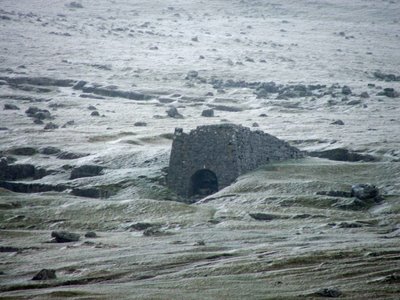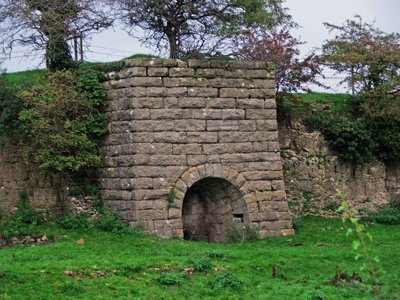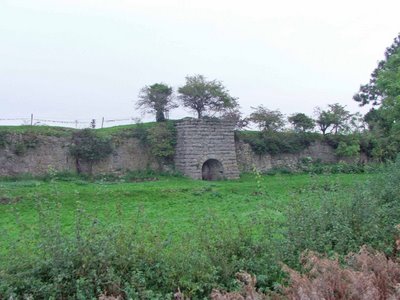Cumbria (and a few in North Yorkshire)
Helsington lime Kiln


 Cunswick Scar lime kiln
Cunswick Scar lime kiln Wild Boar Fell lime kilns
Wild Boar Fell lime kilns

 Longbarn Lime Kiln
Longbarn Lime Kiln This lime kiln lays about 200 yards off the A65 on the South side of the road, at the foot of a steep and narrow hill on the B road heading towards Hutton Roof. The kiln is very overgrown, but in really good condition. I only noticed this by chance as I was making my way to the earthworks outside Hutton Roof.
This lime kiln lays about 200 yards off the A65 on the South side of the road, at the foot of a steep and narrow hill on the B road heading towards Hutton Roof. The kiln is very overgrown, but in really good condition. I only noticed this by chance as I was making my way to the earthworks outside Hutton Roof.
 Lime Kiln at Levens, a quarter of a mile North West of Levens Hall
Lime Kiln at Levens, a quarter of a mile North West of Levens Hall This lime kiln can be seen from the dual carriageway (A590) as you're travelling towards Kendal. The kiln sits in the field on your left, built into a lime stone escarpment. Again, the kiln is in excellent condition. During the summer months, it's pretty much hidden by the roadside hedgerows.
This lime kiln can be seen from the dual carriageway (A590) as you're travelling towards Kendal. The kiln sits in the field on your left, built into a lime stone escarpment. Again, the kiln is in excellent condition. During the summer months, it's pretty much hidden by the roadside hedgerows.
 Lime kiln, Storrs Common Ingleton
Lime kiln, Storrs Common Ingleton
At last, I've photographed this rather sorry lime kiln just outside Ingleton. The mostly buried remains are about 100 yards west of the B6255 on Storrs common. The entrance to the kiln is full of grass covered rubble, but a quick look inside proved it to be in very good condition.
 The kiln was in use in the 1840's, though its date of construction is not known. The area surrounding this kiln, known as Storrs Common, has probably been quarried for centuries, providing good quality lime stone for building and lime production.
The kiln was in use in the 1840's, though its date of construction is not known. The area surrounding this kiln, known as Storrs Common, has probably been quarried for centuries, providing good quality lime stone for building and lime production.
 This was probably the last kiln to be built on the common, and is the only survivor found to date.
This was probably the last kiln to be built on the common, and is the only survivor found to date.
Quarry works, Storrs Common Ingleton
The quarry works in Ingleton are in a poor state. There are a lot of remains at the site, but what's there is pretty ruinous. The kiln is situated on the east banks of the River Doe, on the opposite side of the river to the main part of Mealbank quarry. Its likely that the kiln mostly used lime quarried from the smaller quarry above it, but this would need to be confirmed. The remains also include the infilled ruins of a large kiln built into the hillside to the South of the works.



 Infilled lime kiln to the South of the quarry works.
Infilled lime kiln to the South of the quarry works.
About two miles West of the quarry works and Storrs Common, there is a Hoffman Kiln built by the Craven Lime Company. Two brothers from Austwick, John Clark and Michael Wilson purchased the Meal Bank quarry in 1864, obtaining their license to build a Hoffman kiln four years later in 1868. This was the first Hoffman kiln to be built in the North of England, and at its peak, was producing between 40 and 60 tons of high grade lime a day. My next trip to Ingleton will be to grab some photos of the remains.

Just outside the village of Gleaston, and about a mile and ahalf from Gleaston Castle, this lime kiln, in pretty good condition, still stands in the fields overlooking the B road to the village. The farmer has obviously converted the kiln for farm use, but apart from the obvious changes, it's in excellent condition.
Holme Park Fell lime kiln.

Another fine example of a Cumbrian lime kiln, this time somewhat overgrown, but in good condition. This limekiln can be found on Holm Park Fell, which is about two miles to the South of Fareleton Knot, and a mile and a half East of the village of Holme. I only stumbled on this one really, as it's off the beaten track and as you can see....it's overgrown and well hidden.
Shap lime kilns
Dotted around the fells near Shap abbey, are numerous lime kilns of varying condition. Here are a few that were easily photgraphed.
The first kiln, shown below, is known to date from the mid to late 19th century, and has ramps on the sides, leading to the top of the kiln. In quite good condition.
The next kiln, shown below, was also in good condition, with a shallow trackway leading to the entrance.

The next kiln lay in a shallow 'quarry', perhaps 3 or 4 feet deep, from which lime stone was possibly removed for processing.


There were a number of other kilns that weren't photographed....I'll save them for another day. The area is littered with lime stone outcrops, clearly indicating that the area was ripe for lime stone quarrying.
Arnside Tower Lime Kiln
With Arnside Tower being located along the Limestone Link Walk from Beetham to Kirkby Lonsdale, it's no surprise to find a few lime kilns along the way.

This one is situated right underneath the imposing ruins of Arnside Tower, and probably dates from sometime in the early 18th century.

Partly collapsed and full of rubble, it's a tiny variation on a theme that is common around these parts, with limestone pavements exposed at almost every turn.
Levens Park Lime Kiln.
I only spotted this lime kiln by accident, tiny as the opening is, and damaged and fairly well hidden.

It's only visible from the East banks of the River Kent as it passes through Levens Park. Judgin by the damage on the top, and the silting up of the entrance, I would say that this kiln regularly gets flooded by the Kent.
Ravenstonedale Lime Kiln.
Sad as this may sound, I've only just discovered this lime kiln photo in my library. I know that it's from the Ravenstonedale area, and I know that I took it in September last year...but apart from that, at the moment at least, I don't know where it is.
 As soon as I've worked out where it is situated, I'll have a little more information on it.
As soon as I've worked out where it is situated, I'll have a little more information on it.
3 comments:
There is a very good Lime Kiln, and several others, at The Row in the Lyth Valley. Just ripe for photographing.
Thank goodness for someone making a record of our industrial heritage. Although one could well be wearing rose tinted glasses, but these scenes (and any archeo. evidence and historic photo's) are of prime importance. Thank you for making them.
There is also the lime kiln at the top of Greenside in Kendal that has recently recieved quite a lot of publicity.
Post a Comment